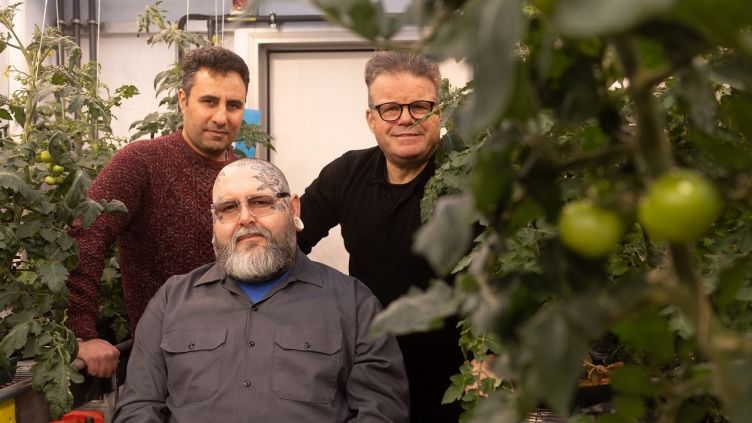How can we feed the world with foam?
An abandoned school isn’t where you’d expect to find researchers trying to solve the problem of feeding a world of 10 billion. Then again, neither is a refugee camp. But this team of University of Sheffield researchers are nothing short of resourceful.
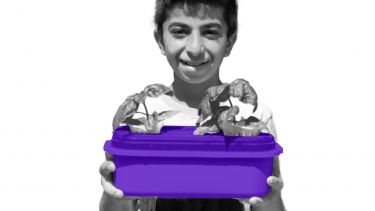
The Desert Garden appeal
A unique project born out of innovative Sheffield science is giving families displaced by war the opportunity to grow fresh food in the desert using the most unlikely of materials – discarded mattresses. But time is running out. Without your help, the Desert Garden project will end. Will you help secure its future?
The mattress moment
Summer temperatures in Zaatari refugee camp in Jordan – the world’s largest camp for people displaced by the Syrian Civil War – reach around 37℃. So when University of Sheffield researcher Tony Ryan visited he was relieved to be invited out of the glaring heat and into the comparative cool of one of the camp’s warehouses. Inside, piled from floor to ceiling, were mattresses. Used, discarded mattresses.
Tony, a Chemistry Professor from the University of Sheffield, and his team were in Zaatari working with refugees to develop useful products out of waste materials. They were converting surplus bikes that had been fished from canals 4,000 miles away in Amsterdam into rickshaws to take children to school, wind turbines for power and walking frames for children with cerebral palsy. The mattresses, however, marked the beginning of something even greater…
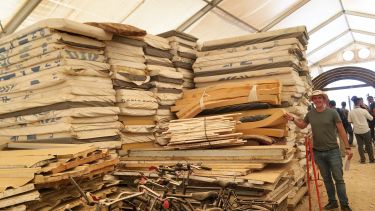
Life as a refugee
Refugee camps are temporary settlements by definition and the images that flash across the news are often those of improvised, impersonal homes. But that’s in part because those living there aren’t allowed to do anything that suggests their settlement is permanent; having a job, fixing their home or planting into the ground are all forbidden. This is the reality of camp life. Zaatari’s refugees have come from a world where they were farmers, engineers and doctors and now they’re stripped of not only their homes, but much of what defined who they were.
The majority of the 80,000 refugees in the Zaatari camp came from the Dara’a region in Syria, a region known for its fertile soil and an abundance of farmers. But, the soil in Zaatari is salty and low in organic matter. Even if the camp’s farmers were able to plant into the ground, the conditions make it less than ideal. A lack of water also presents a challenge. Each refugee in the camp receives 37 litres of water a day, which sounds like a lot, but not when you need 214 litres of water to produce a kilo of tomatoes. What the refugees didn’t realise was that they had a warehouse full of solutions.
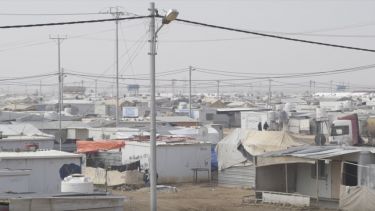
A new use for old beds
Before his trip to Zaatari, Tony and his colleague Professor Duncan Cameron, a Soil Microbiologist at the University of Sheffield, had taken on a PhD student, Harry Wright. Harry’s PhD research focuses on the use of polyurethane foams to grow high value crops for food production. When Tony was shown the mattresses, the penny dropped. “The two things just came together,” he said. The mattresses could be repurposed as a growing medium for plants.
But where did these mattresses come from in the first place? It turns out the UN Refugee Agency, who are responsible for the Zaatari camp as well as others, provide its inhabitants with polyurethane foam mattresses as part of the basic setup. However, once these mattresses have been used they can’t be reused by someone else, but they can be repurposed.
So this is what they did. They used the foam as a growing medium for the crops in a hydroponic system. In normal agricultural processes, soil supports a plant’s roots, but in a hydroponics system plants are supported artificially and suspended away from the ground. The mattress foam provided the artificial support for the plant. Nutrient solutions and water can then be pumped into the foam for the plant. Unlike the soil in Zaatari, the foam holds onto all of this, so it’s constantly available for the plant to use.
Given the soil conditions and regulations in the refugee camp, this was a winning solution. It had the potential to give the farmers the opportunity to apply their years of experience and skills to meaningful purpose, and at the same time produce food to eat and sell.
After the idea was introduced and the refugees were trained in the basic principles, the project took on a life of its own. The camp’s residents applied their years of farming experiences to the principles of hydroponics and soon after the system went live. For Tony this was a powerful motivator.
“I learnt a lot from people who are farmers, and the power of truly multidisciplinary teams. The key thing is trust. You need to want to take your science out of its silo with people who you can benefit from and who can benefit from you,” he said.
Across the camp more than 3000 refugees have been trained to use mattress foam as an alternative to soil. “A lot of the residents seem to keep coming back with more and more resources and nutrients. One person I trained has 200 plants he’s growing hydroponically,” said Harry. For its residents, life in a refugee camp can be unpredictable. But this work is bringing purpose and structure. “It’s allowing people to have a mug of mint tea whenever they want,” Tony tells us.
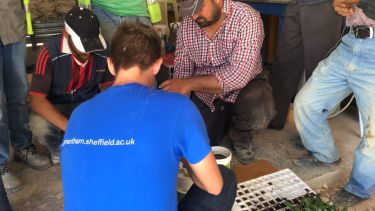
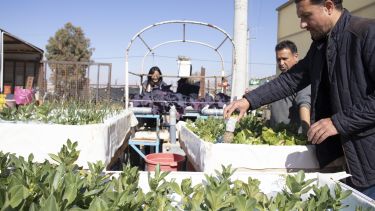
This work means Zaatari’s residents no longer have to rely completely on external charities for food to eat or sell and trade. But this wouldn’t have been possible without the refugees themselves. They taught the Sheffield team how to truly optimise plant growth in these systems and how to make it work on a community level. And now these lessons are being applied to a new project, more than 3000 miles away, back in Sheffield.
The urban farm
An abandoned school in Tinsley in Sheffield isn’t the first place you’d think to build a farm, but that didn't stop Jake Nickles. Jake, a Knowledge Exchange Associate at the University of Sheffield, turned the Tinsley space into an urban farm which, much like the system in Zaatari, relied on hydroponics to grow crops. But, unlike Zaatari, Sheffield doesn’t have the same availability of mattress foam, so an alternative solution for the hydroponics system had to be found.
As part of Harry’s PhD he was developing different foams that could be used commercially in hydroponics systems. The foam development is coming along well, but it’s not without its challenges. To get the foam to best resemble soil small bits of clay are added which make the foam more closely resemble the physical properties of soil, but these block up the machine being used to make the foam. So it’s a work in progress, but since the project began two more PhD students have been recruited to help with its development as well as looking at ways to make the foam biodegradable. And there’s a definite need for an optimised growth medium. Currently industry standards, like rockwool, are used to grow crops on a commercial scale but these come with a set of disadvantages. Rockwool requires really high energy to make and once it’s done with it’s difficult to get rid of in a safe and sustainable way.

“Hydroponics isn’t new, but it’s nice to see it optimised,” Jake says. The work on foam is attempting to develop a resource that chemically, physically and biologically resembles soil. But the work is also trying to make it even better than soil and so far it’s succeeding. The plants grown in this urban setting grow two to ten times faster than they do in soil, however, this isn’t down to the hydroponics alone. The system has been combined with controlled growing environments and low cost technology. And it does all this whilst staying cost effective.”
Unfortunately, due to funding challenges and the Covid-19 pandemic, the Tinsley Urban Farm had to be dismantled. The team are still investigating foams in the labs at The University of Sheffield, and hope to be able to set up a similar hydroponic urban farm, that can bring fruit and vegetables to local communities, in the future.
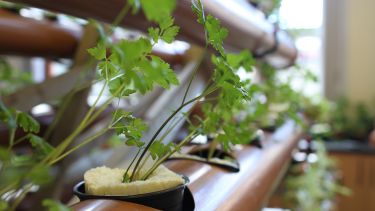
Feeding the world
The work in Zaatari has proven that we can grow crops in the middle of the desert, in the height of summer with little more than some foam from an old mattress. And if we can do that, it’s no wonder that with a little extra technology and environmental control, we can grow the very food we need to put onto our own supermarket shelves in a local and sustainable way.
“For me, the beautiful part of the story is that the things we’ve learnt in a refugee camp have now been applied to Sheffield,” Tony tells us.
Across the planet there are 2 billion people who are chronically hungry. That’s over a third of the world. With the population set to grow to 10 billion by 2050, if something doesn’t change the problem will only get worse. These projects alone won’t feed the world, but they’ll certainly take some of the pressure off.
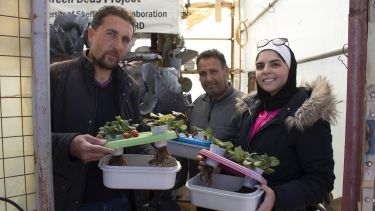
The reverse greenhouse
In Oman, a country that borders Saudi Arabia, food prices soar to quadruple their usual price in the summer when temperatures reach highs of 50°C. The Sheffield team took on this challenge as part of their work to find solutions to the world’s growing food crisis. The solution they found was a greenhouse, but not your ordinary greenhouse. This was designed to provide a cooler environment, rather than a hotter one, using evaporative cooling. It also encompassed technology from across the University, giving it truly multidisciplinary power. They built a desalination system that required little more than power generated by the sun and converted seawater into freshwater, an evaporative cooling system, as well as hydroponics and aquaponics.
The benefit of such a greenhouse is that it could become a ‘drop package’, one that could be transported all over the world and provide food on a local scale. The greenhouse can be adapted to any country in the world; if it’s not hot then evaporative cooling can be omitted or if there’s an abundance of freshwater then solar desalination is unnecessary.
The greenhouse has been instrumental in demonstrating that the functional technologies required to grow crops in the middle of Omani summer work, and have the potential to be applied elsewhere. It’s the same functional technology that’s supported the work in Zaatari and in Sheffield. “Oman taught us how to do what we needed to do in Zaatari in the right place, and it’s where the foundational technology was proved to work,” says Duncan.
Can microcosm farming help us feed a world of 10 billion?
Winner of the The Quorn ‘Pioneers Film Fund’
In September 2021, Quorn launched a special initiative to inspire creative filmmakers to come together and raise awareness of one of humanity’s biggest challenges: the future of our food.
The Quorn ‘Pioneers Film Fund,’ created in association with planetSHINE was set up to kick-start an important conversation around the future of our food.
The Catastrophe Garden - a film about The University of Sheffield's Desert Garden project was one of the three winning films.
It is a daring idea: to grow food from old mattresses in a desolate camp at the edge of a war zone. This is the extraordinary story of three eccentric scientists and their mission to feed Syrian refugees, amid unfolding personal disasters. Low-carbon, local food, grown from waste, in one of the driest and most punishing environments in the world. If it works, it could help hundreds of thousands of people.
For more information about the Film Fund, visit: https://www.quorn.co.uk/whats-new/pioneers-of-food
Film produced by Smoke Trail Productions
Written by:
Alicia Shephard
Research Marketing and Content Coordinator
University of Sheffield
+44 114 222 1033
alicia.shephard@sheffield.ac.uk
Further information
Read more of our research impact
Websites
The Grantham Centre for Sustainable Futures
Funders, awards and key grants
Department for Business, Energy and Industrial Strategy
Global Challenges Research Fund
Biotechnology and Biological Science
Higher Education Innovation Fund
International Institute for Research and Innovation
Foreign & Commonwealth Office Science & Innovation Network for the Gulf
Engineering and Physical Sciences Research Council
Research profiles
Duncan Cameron, University of Sheffield
Tony Ryan, University of Sheffield
Tony Ryan, Grantham Centre for Sustainable Futures
Harry Wright, Grantham Centre for Sustainable Futures


